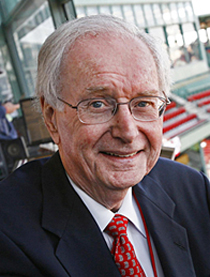
Culture
Back in the '60s there was another Fenway Park monster, and he was the real deal. His name was Dick Radatz.

Flavin
Before Fenway Park had a Green Monster, it had an honest-to-God real monster.
The left field wall has been called the Green Monster for only the past 30 or so years. Before that, it was referred to simply, and often ruefully, as The Wall. Back in the '60s, there was another Fenway Park monster, and he was the real deal. His name was Dick Radatz.
When he broke in with the Red Sox in 1962, he hit the American League with the force of a hurricane. He was a giant of a man, standing six feet, six inches tall and weighing, by his own reckoning, at least 250 pounds. Radatz possessed a blazing, virtually unhittable, fastball that he threw 90 percent of the time.
When he emerged from the golf cart that in those days ferried relievers in from the bullpen, his bulk and fearsome demeanor made it look for all the world to opposing batters like a huge beast had come into the game. He quickly became known throughout the league as The Monster.
The moniker itself was said to have been originated by Mickey Mantle, who supposedly used it after a frustrating at-bat. Mantle had particular trouble hitting against Radatz, and an urban myth grew over the years that the two had squared off against one another 63 times and that Mantle had struck out 47 of those times. It was a story repeated so often that it was reported as fact until author Bill Nowlin had someone research it. It turned out that Mantle had only faced Radatz 16 times over their careers, but that he'd struck out on 12 of them, a ratio of three Ks in every four at bats.
In his entire big-league career, Radatz never made a single start, having been converted to a relief pitcher by manager Johnny Pesky while they were both with the Seattle Rainiers of the Pacific Coast League. In his time with the Red Sox, the "save" was not yet an official statistic, and he was used far differently than present-day closers who, as a rule, are limited to only an inning or less per game. For example, the most innings pitched by a Red Sox reliever in 2019 was 78; in his years with the Sox, Radatz never pitched fewer than 124 innings, and was often called upon to throw three, four, or even more innings. Then, he'd likely be summoned into a game the following night.
In a time when Red Sox fans had little to cheer about, he became a great favorite. In his rookie year of 1962, he won the Fireman of the Year award. Fans who did go to games back then, showed up in the hope of seeing him pitch, and they were very often rewarded. In 1963, he had 23 saves (computed retroactively, after saves became an official stat) to go with 15 wins for a total of 38 wins and saves combined, 50 percent of the Red Sox total of 76. Then, in 1964, he was even better; he struck out 181 hitters, still a major-league record for a relief pitcher. He led the American League with 29 saves and set a then American-League record for relievers with 16 wins. Between his saves and his wins, he played a vital role in an incredible 45 of the team's 72 wins that year, more than 60 percent of the total.
On getting the final out of a game, he'd thrust his hands skyward in celebration, a trademark gesture that fans waited for before leaving Fenway Park.
Boston loved the "Monstah."
But beginning in 1965, his fastball began losing its velocity. Had he been overused? Had his mechanics become messed up by his constant experimenting with other pitches to add to his repertoire? In either case, he never complained of a sore arm, but his ERA increased while his strikeouts, saves, and wins all fell off. When the trend continued the following year, he was traded to the Cleveland Indians at mid-season. He'd been a major star in Boston, but then he seemed to disappear from sight. After struggling with the Indians, Cubs, Tigers, and Expos, the monster who had dominated quietly retired in 1969 to suburban Detroit, where he had grown up.
He lived there, out of the spotlight, for 15 years, but in 1984, his old friend and battery mate, Jerry Moses, talked him into relocating to the Boston area, where he'd spent his glory years.
He soon discovered that Red Sox Nation had not forgotten him; after almost two decades away from the spotlight, he resurfaced as a genuine celebrity. His garrulous humor and gifted story-telling ability made him a sought-after speaker and a regular on sports-talk radio. He had a booming laugh and a deep baritone voice that perfectly complemented his imposing physique, which by then had ballooned up to around 400 pounds.
He was larger than life in every way: a colorful character renowned among his friends for his ability to sit all night at a card table, telling stories of the old days, his infectious laughter filling the room, and taking occasional breaks to "salute the captain," his catch-phrase for having a drink of his favored adult beverage, Captain Morgan's Rum.
He'd become a superstar in Boston for the second time.
With the passage of years, he began to have trouble getting around, his legs having suffered the wear and tear of bearing the weight of his massive torso for so many years.
On Wednesday, March 16, 2005, he lost his balance while on the basement stairway of his home in Easton, Massachusetts, and fell head first down the stairwell. His massive skull crashed onto the carpet-covered concrete floor, killing him. He was 67 years old.
Fifteen years after his death, the retelling of his brief but hugely-dominant years as a pitcher for the Red Sox, and of his resurgence as an A-list celebrity 20 years later, seems to have a myth-like quality to it. But it all really happened. Proof of that is found in a picture that hangs on the office wall of his son, Dick, Jr., who is the co-founder and chairman of the Northwoods League, a 22-team league of elite college players based in the upper midwest.
The picture is of a very famous ballplayer, and it bears the salutation, "To the toughest I ever faced." It's signed by Mickey Mantle.
- Dick Flavin is a New York Times bestselling author; the Boston Red Sox "Poet Laureate" and The Pilot's recently minted Sports' columnist.
Recent articles in the Culture & Events section
-
'Dignitas' and the mediaRussell Shaw
-
Scripture Reflection for April 14, 2024, Third Sunday of EasterDeacon Greg Kandra
-
St. Helena's House is established in the South EndThomas Lester
-
Is this synodality?Russell Shaw
-
Poking the hornet's nest of IVFFather Tadeusz Pacholczyk


















